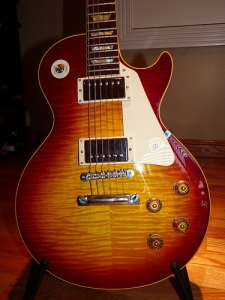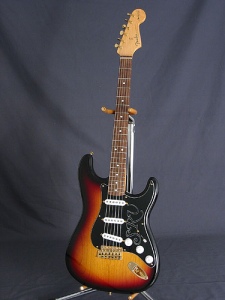As many readers may know, a trademark need not be a name or a logo. A trademark can be almost any element that identifies your goods and distinguishes them from your competitors’ goods. Even the shape of the product itself, or the shape of some specific component or element of the product, can serve as a trademark provided the configuration of that feature is not functional in some way.
The musical instrument industry, being as competitive as any other, has taken advantage of this fact by registering “configuration” trademarks. As a musician and compulsive guitar freak aficionado myself, I thought it might be interesting to examine the way that guitar trademarks have helped to shape the industry.
Of course, traditional “brand name” trademark disputes have played their own role in the development of the guitar industry. Indeed, Fender Guitars’ iconic TELECASTER guitar – the original solid-body electric guitar and the signature axe of rockers like Keith Richards, Bruce Springsteen and Joe Strummer – was originally called the BROADCASTER. Soon after the guitar’s introduction Fender received a cease-and-desist letter from the good people at Gretsch, who used BROADKASTER as a trademark for drums.
Fender quickly switched over to the TELECASTER mark, after a transition period in which it sold a small number of guitars with the BROADCASTER sticker removed and thus no name sticker on the headstock. Because of their extreme rarity the Fender BROADCASTER guitars, along with the nameless guitars (dubbed “No-Casters” by guitar buffs), command a huge premium in the vintage guitar market.
Copy Guitars – Where the Action Is
In fact, however, infringements of actual trademark names are relatively rare in the guitar industry. No one is selling CIBSON or VENDER guitars, to my knowledge. The real action, and the most interest, lies with the issue of so-called “copy” guitars.
Some background: Guitarists are nothing if not reverent of the past, and thus there are a limited number of iconic guitar designs. Most of these date from the 1950s, the dawn of the electric guitar era. Gibson’s LES PAUL, SG and ES-335 models, Fender’s TELECASTER and STRATOCASTER guitars, various RICKENBACKER brand guitars – these are among the few truly iconic guitar models. In recent decades, PAUL REED SMITH guitars, named after the company’s founder, have joined those elite ranks.
Almost from the beginning Gibson and Fender, makers of most of the legendary models, chose not to challenge copy guitars unless the copy was virtually identical to the original. By the term copy guitars, I mean lower-cost (often much lower-cost, and usually foreign-made) copies of the “big name” guitar models.
Even beginning guitarists want to look (if not, unfortunately, play) like their guitar heroes. Therefore, most beginners want an axe that closely resembles one of the celebrated big-league guitar models mentioned above. As a result, each copy manufacturer tries to get as close in appearance to those famous axes as possible, without provoking an infringement challenge.
Some companies, such as Ibanez, started out as copyists before succumbing to infringement threats and developing their own models. Many now would rank some IBANEZ models as iconic guitars, subject to copyists of their own.
Personally I am a fan of the higher-quality copy guitars, of which there are many. In my humble opinion there’s nothing in my hacker’s technique that requires a multi-thousand dollar guitar, especially when I can get 80% of the instrument for 10% of the price.
Who Protects What?
Many of the elite guitar manufacturers have sought protection against the most slavish copyists by registering the appearance or configuration of their guitars. More specifically, they have sought protection for certain specific elements of the guitars.
In recent years, with growing awareness of the competitive advantages of trademark registration, the guitar companies have increased the number of elements they register as trademarks. Generally speaking, the top-shelf companies have sought protection for guitar body and headstock shapes. It can generally be said that each manufacturer seems to have drawn a line in the sand and focused upon preventing the reproduction of one or two particular features of its flagship models:

Gibson energetically enforces its rights in the "open book" design at the top of its guitar headstocks.
Gibson jealously protects the “open book” shape at the top of its headstocks, as well as the particular shape of the cutaways on its legendary LES PAUL and SG models. (Cutaways are the body indents on one or both sides of the neck, which allow a player easier access to the highest frets when soloing.)
Fender protects headstock shapes, and especially those of the iconic STRATOCASTER and TELECASTER models. The company recently attempted to reverse the course of history and seek registration protection for its STRAT and TELE body designs. Fender failed in that attempt when a large number of other guitar makers opposed the applications. The gist of the other makers’ argument was that Fender had allowed decades of widespread copying of those body designs, and as a result the configurations did not distinguish Fender’s guitars from any of the countless copies. See the allegations in one of the oppositions here.
Paul Reed Smith chooses to protect its headstock, its signature “birds in flight” fretboard inlays, and the beveled edge of its cutaway (see more below.)
Rickenbacker, whose legendary guitars were widely used by the Beatles and the Byrds, is one of the few guitar makers that has protected both body shapes and headstock shapes for decades. Rickenbacker also traditionally has been far more energetic in pursuing copyists than its peers, with the result that there are very few Rickenbacker copies to be found.
My “Lawsuit” Guitar Is Worth An Extra Hundred Bucks!
At certain points in the past (especially the 1970s), the major guitar companies have responded to particularly exact copy guitars by threatening or actually bringing trademark infringement suits. The belief has arisen, whether true or not, that the major guitar companies were spurred into action by the equal or greater quality of the foreign copy guitars, and the resulting loss of market share for their much costlier products.
I suspect that very few lawsuits actually were filed, but doubtless some cease and desist letters were sent. Nevertheless, the phrase “lawsuit guitar” is bandied about quite freely by those selling used guitars on eBay and elsewhere, to lend a certain cachet and to seek a little extra in price.
Big v. Big
Notwithstanding the foregoing, it’s not always the big guys going after the little-guy copyists. Occasionally, the battle is Big v. Big. In 2001, Gibson sued Paul Reed Smith Guitars, alleging that PRS’ “Singlecut” model infringed Gibson’s rights in the configuration of its LES PAUL guitar. In my own opinion, the Singlecut looked no more like a Gibson LES PAUL than countless other copy guitars. Nevertheless, Gibson prevailed at the trial court level and for a time PRS was forced to stop making the Singlecut model.
Gibson saw its judgment overturned by the 6th Circuit Court of Appeals, however. The appellate court emphasized Gibson’s courtroom concession that “only an idiot” would confuse the two models at the point of sale. PRS immediately resumed marketing the Singlecut model. It may come as no surprise that guitar buffs, ever sensitive to tiny nuances of relative prestige, have come to distinguish the original “pre-lawsuit” Singlecuts from those that came later.
PHOTOS COURTESY OF FLICKR USERS MRBILL (STRATOCASTER headstock and guitar), BGVJPE (Gibson and PAUL REED SMITH headstocks), ETHAN PRATER (LES PAUL headstock) and BANJO D (RICKENBACKER guitar), ALL UNDER THIS CREATIVE COMMONS LICENSE.





